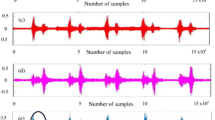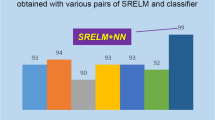Abstract
Surface electromyogram (EMG) signals collected from amputee’s residual limb have been utilized to control the prosthetic limb movements for many years. The extensive research has been carried out to classify arm and hand movements by many researchers. However, for control of the more dexterous prosthetic hand, controlling of single and multiple prosthetic fingers needs to be focused. The classification of single and multiple finger movements is challenging as the large number of EMG electrodes/channels are required to classify more number of movement classes. Also the misclassification rate increases significantly with the increased number of finger movements. To enable such control, the most informative and discriminative feature set which can accurately differentiate between different finger movements must be extracted. This work proposes an accurate and novel scheme for feature set extraction and projection based on Sparse Filtering of wavelet packet coefficients. Unlike the existing feature extraction-projection techniques, the proposed method can classify a large number of single and multiple finger movements accurately with reduced hardware complexity. The proposed method is compared to other combinations of feature extraction-reduction methods and validated on EMG dataset collected from eight subjects performing 15 different finger movements. The experimental results show the importance of the proposed scheme in comparison with existing feature extraction-projection schemes with an average accuracy of 99.52% ± 0.6%. The results also indicate that the subset of five EMG channels delivers similar accuracy (>99%) to those obtained from all eight channels. The resultant accuracy values are improved over the existing one reported in the literature, whereas only one-third numbers of channels per identified motions are employed. The experimental results and analysis of variance tests (p < 0.001) prove the feasibility of the proposed work.





Similar content being viewed by others
References
Khushaba R, Al-Jumaily A and Al-Ani A 2007 Novel feature extraction method based on fuzzy entropy and wavelet packet transform for myoelectric control. In: 7th International Symposium on Communications and Information Technologies ISCIT, Sydney, Australia, pp. 352–357
Hudgins B, Parker P and Scott R 1993 A new strategy for multifunction myoelectric control. IEEE Trans. Biomed. Eng. 40(1): 82–94
Al-Timemy A, Bugmann G, Escudero J and Outram N 2013 Classification of finger movements for the dexterous hand prosthesis control with surface electromyography. IEEE J. Biomed Health Inform. 17(3): 608–618
Tsenov G, Zeghbib H, Palis F, Shoylev N and Mladenov V 2006 Neural networks for online classification of hand and finger movements using surface EMG signals. In: Proceedings of the 8th Seminar on Neural Network Applications in Electrical Engineering, pp. 167–171
Phinyomark A, Khushaba R and Scheme E 2018 Feature extraction and selection for myoelectric control based on wearable EMG sensors. Sensors 18(5). pii: E1615. https://doi.org/10.3390/s18051615
Jiang M, Wang R, Wang J and Jin D 2005 A method of recognizing finger motion using wavelet transform of surface EMG signal. In: Proc. 27th Annual International Conference of the IEEE-EMBS Engineering in Medicine and Biology Society, pp. 2672–2674
Tenore F, Ramos A, Fahmy A, Acharya S, Etienne-Cummings R and Thakor N 2009 Decoding of individuated finger movements using surface electromyography. IEEE Trans. Biomed. Eng. 56(5): 1427–1434
Baldacchino T, Jacobs W, Anderson S, Worden K and Rowson J 2018 Simultaneous force regression and movement classification of fingers via surface EMG within a unified Bayesian framework. Front Bioeng. Biotechnol. 6: 13, https://doi.org/10.3389/fbioe.2018.00013
Khushaba R and Kodagoda S 2012 Electromyogram (EMG) feature reduction using mutual components analysis for multifunction prosthetic fingers control. In: Proc. International Conference on Control, Automation, Robotics & Vision, Guangzhou, pp. 1534–1539
Phinyomark A, Quaine F, Charbonnier S and Serviere C 2013 EMG feature evaluation for improving myoelectric pattern recognition robustness. Expert Syst. Appl. 40(12): 4832–4840
Rafiee J, Rafiee M, Yavari F and Schoen M P 2011 Feature extraction of forearm EMG signals for prosthetics. Expert Syst. Appl. 38(4): 4058–4067
Boostani R and Moradi M 2003 Evaluation of the forearm EMG signal features for the control of a prosthetic hand. Institute Of Physics Publishing. Physiol. Meas. 24(2): 309–319
Liu J, Zhang D, Sheng X and Zhu X 2014 Quantification and solutions of arm movements effect on sEMG pattern recognition. Biomed. Signal Process. Control 13: 189–197
Zhang X, Wang Y and Han R 2010 Wavelet transform theory and its application in EMG signal. In: Processing Seventh International Conference on Fuzzy Systems and Knowledge Discovery vol. 5, pp. 2234–2238
Riilloa F, Quitadamoa L, Cavrinia F, Gruppionic E, Pintob C, Cosimo P and Sberninid L 2014 Optimization of EMG-based hand gesture recognition: supervised vs. unsupervised data preprocessing on healthy subjects and transradial amputees. Biomed. Signal Process. Control 14(0): 117–125
Dong Y, Shi H, Luo J, Fan G and Zhang C 2010 Application of wavelet transform in MCG-signal denoising. Modern Appl. Sci. 4(6): 20–24
Ngiam J, Chen Z, Bhaskar S, Pang W and Ng A 2011 Sparse filtering. Adv. Neural Inf. Process. Syst. 24: 1125–1133
Wang J, Li S, Jiang X and Cheng C 2017 An automatic feature extraction method and its application in fault diagnosis. J. Vibroeng. 19: 2521–2533
Zennaroa F and Chen K 2016 Towards understanding sparse filtering: a theoretical perspective. Preprint arXiv:1603.08831
Phinyomark A, Limsakul C and Phukpattaranont P 2010 Optimal wavelet functions in wavelet denoising for multifunction myoelectric control. In: Proceedings of the Electrical Engineering/Electronics, Computer, Telecommunications and Information Technology, Pattaya 6–9; pp. 1098–1101
Oskoei M A and Hu H 2007 Myoelectric control systems—a survey. Biomed. Signal Process. Control 2(4): 275–294
Englehart K and Hudgins B 2003 A robust, real-time control scheme for multifunction myoelectric control. IEEE Trans. Biomed. Eng. 50(7): 848–854
Mahdi K and Mehran J 2007 Real-time intelligent pattern recognition algorithm for surface EMG signals. BioMedical Eng. OnLine, 6: 45 https://doi.org/10.1186/1475-925x-6-45
Phinyomark A, Limsakul C and Phukpattaranont P 2011 Application of wavelet analysis in EMG feature extraction for pattern classification. Meas. Sci. Rev. 11(2): 45–52
Phukpattaranont P, Thongpanja S, Anam K et al 2018 Evaluation of feature extraction techniques and classifiers for finger movement recognition using surface electromyography signal. Med. Biol. Eng. Comput. 56: 2259. https://doi.org/10.1007/s11517-018-1857-5
Chan A and Green G 2007 Myoelectric control development toolbox. 30th Conference of the Canadian Medical & Biological Engineering Society, Toronto, Canada, M0100
Zhang D, Zhao X, Han J and Zhao Y 2014 A comparative study on PCA and LDA based EMG pattern recognition for anthropomorphic robotic hand. In: IEEE International Conference on, pp. 4850–4855
Goge A and Chan A 2004 Investigating classification parameters for continuous myoelectrically controlled prostheses. In: Proceedings of 28th Conference of the Canadian Medical & Biological Engineering Society, Canada, pp. 141–144
Acknowledgements
The authors would like to thank Dr. Rami Khushaba for making EMG DATASET [1] publically available. The authors would also like to acknowledge the constructive feedback from both reviewers, and the editor, that helped enhancing the quality of this paper.
Author information
Authors and Affiliations
Corresponding author
Rights and permissions
About this article
Cite this article
BHAGWAT, S., MUKHERJI, P. Electromyogram (EMG) based fingers movement recognition using sparse filtering of wavelet packet coefficients. Sādhanā 45, 3 (2020). https://doi.org/10.1007/s12046-019-1231-9
Received:
Revised:
Accepted:
Published:
DOI: https://doi.org/10.1007/s12046-019-1231-9




